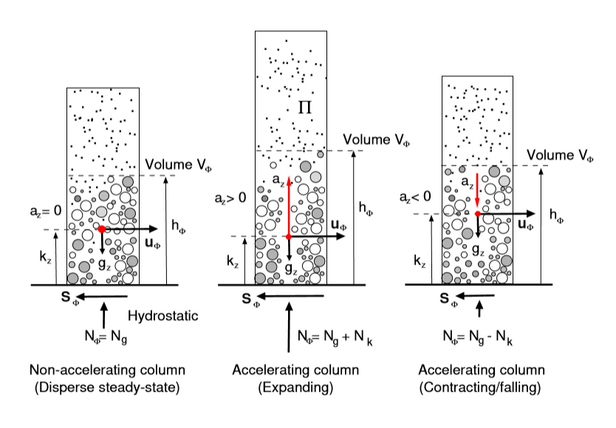The avalanche cloud is mathematically treated as an inertial, turbulent suspension. An additional system of four depth-averaged equations is solved to tract the cloud velocity, mass and height from initiation to runout. The driving force of the cloud arises from mass, momentum and turbulent energy exchanges between the core and the cloud. The formation of the cloud removes momentum from the core. The transfer is one-way; that is, once the cloud is formed there is no return of mass and momentum back to the core. The air in the powder cloud is treated as incompressible; the cloud density is given by the amount of ice-dust mass in the cloud volume.
Once the cloud is formed, the movement of the cloud is modelled independently from the core. The motion of the core, a surface flow, is governed by terrain features. As an airborne suspension, the motion of the cloud is governed by the air entrainment, dissipation of turbulent structures and ice-dust/air drag. The formation of the powder cloud, however, is strongly coupled to the flow state of the avalanche core at initiation: the core continually provides the cloud with momentum and the transfer of momentum is accompanied by the transmission and creation of small scale turbulent structures.
The process of cloud formation begins when particles in the core begin to disperse, opening of space between particles and facilitating the intake (or consumption) of air, especially at the avalanche front. Slope-perpendicular accelerations provide the location of the highest particle in the core. The location of this particle defines the boundary between the core and the cloud (Fig. 1). All the air in the core, beneath the highest particle, is assumed to be laden with ice-dust and moving with the speed of the core. We therefore assume that there is no relative velocity between the air and the dust. Changes in core volume are always associated with the intake and/or outtake of air.

Both the expansion and contraction of the core is associated with the cloud formation. As the core volume begins to contract, air is extruded out of the particle ensemble, providing even more mass and momentum to the cloud. The end result of the expansive/contractive processes in the core is form a turbulent ice-dust suspension travelling at high speed and some height above the core. The transfer of ice-dust mass from the core to the cloud is escorted with a transfer of momentum (and turbulent fluctuation energy) which provides the powder cloud with its initial velocity and vorticity. Momentum is supplied to the cloud in both coordinate directions which allows the simulation of the lateral spreading of the cloud, an important problem in hazard mitigation studies. Because the RAMMS::EXT model tracks volume changes in the core resulting from different disperse particle configurations, the volume of air injected into the cloud is always constrained by the configurational energy fluxes in the core (and the therefore the production and decay of random kinetic energy). This fact places growth constraints on the cloud height, density and speed. More air is added to the cloud by turbulent air entrainment, diluting the powder cloud density.